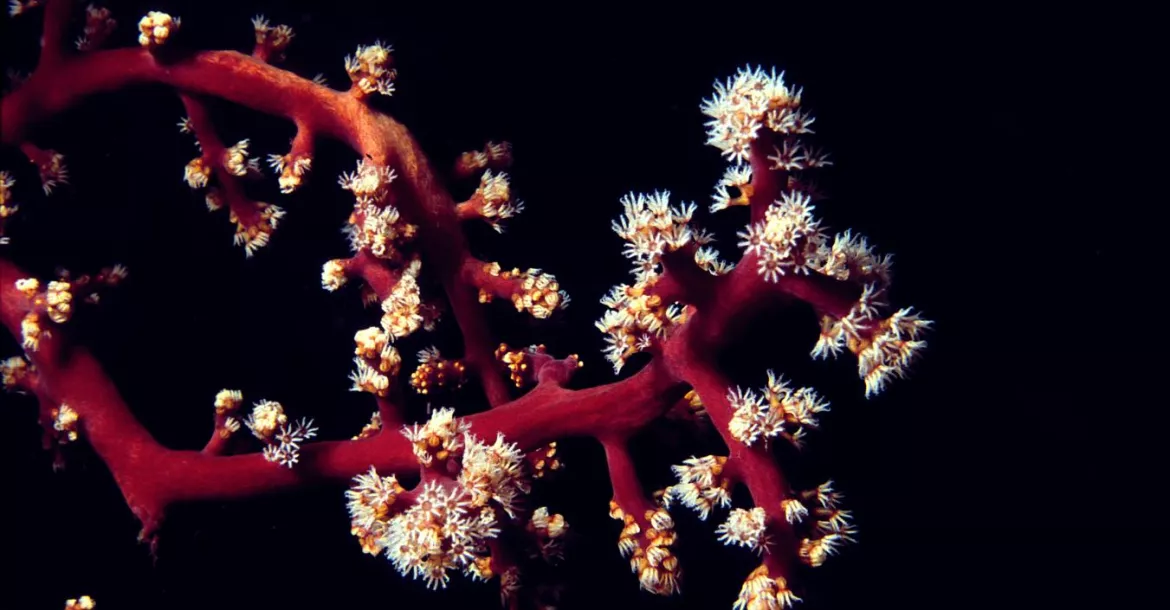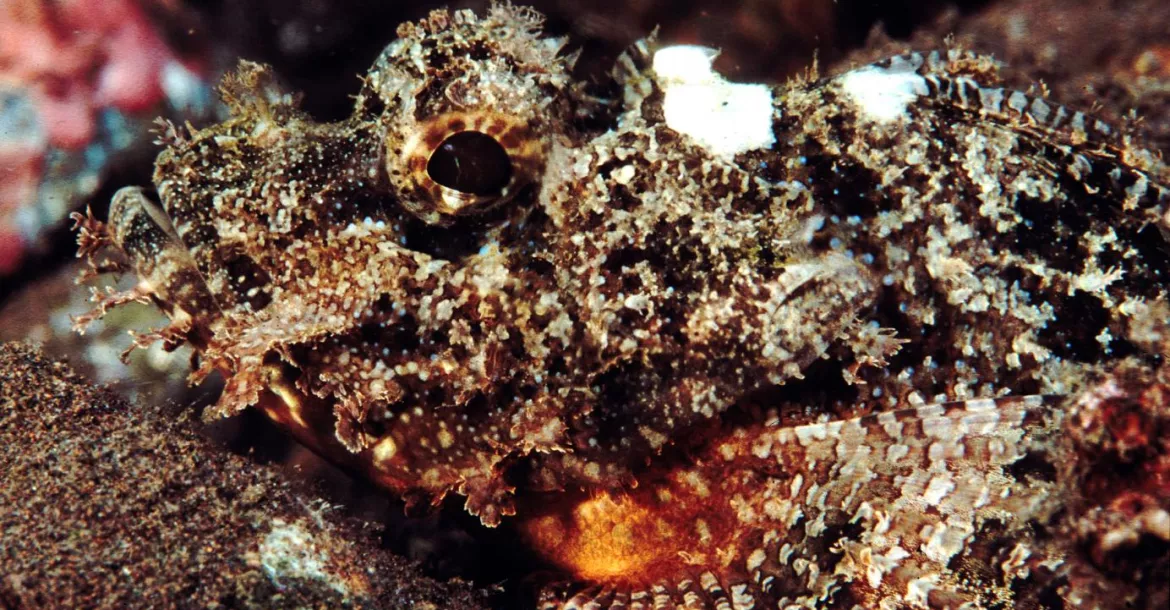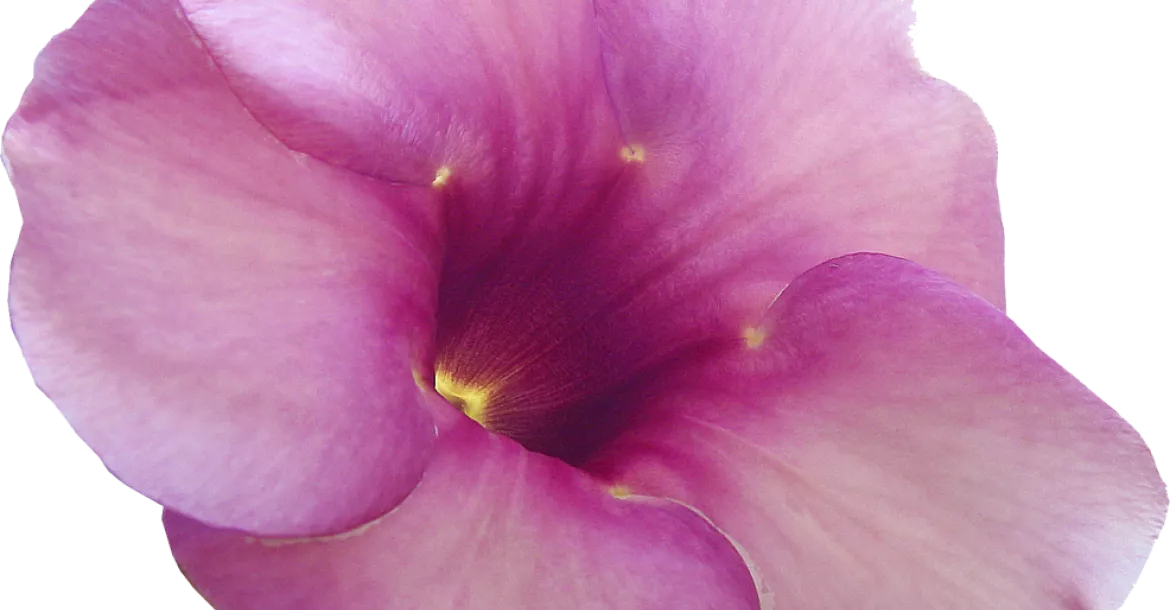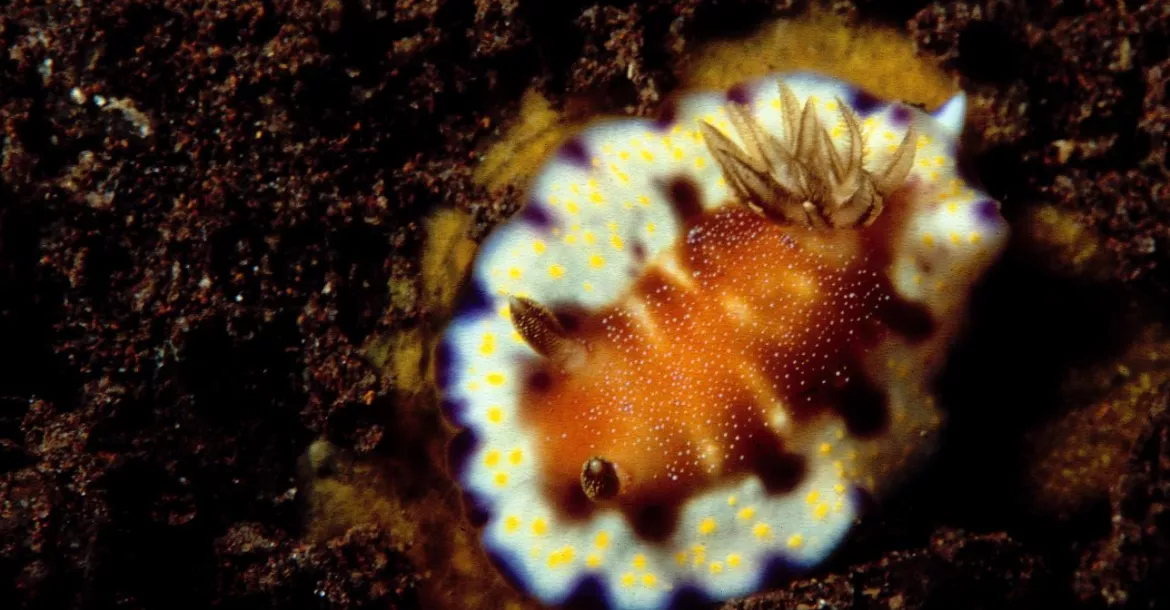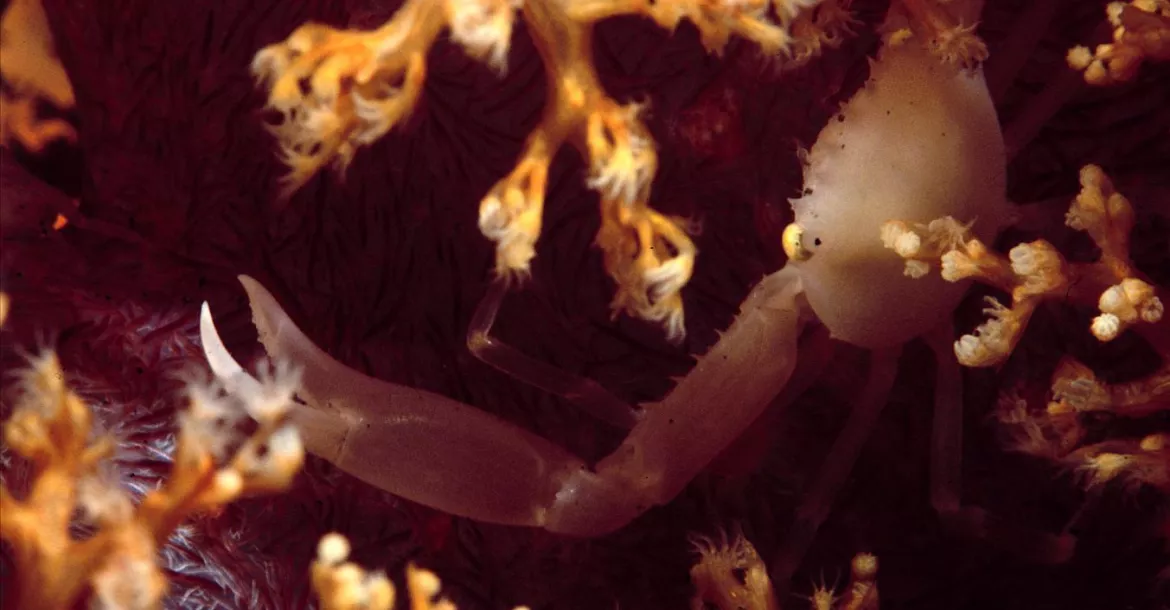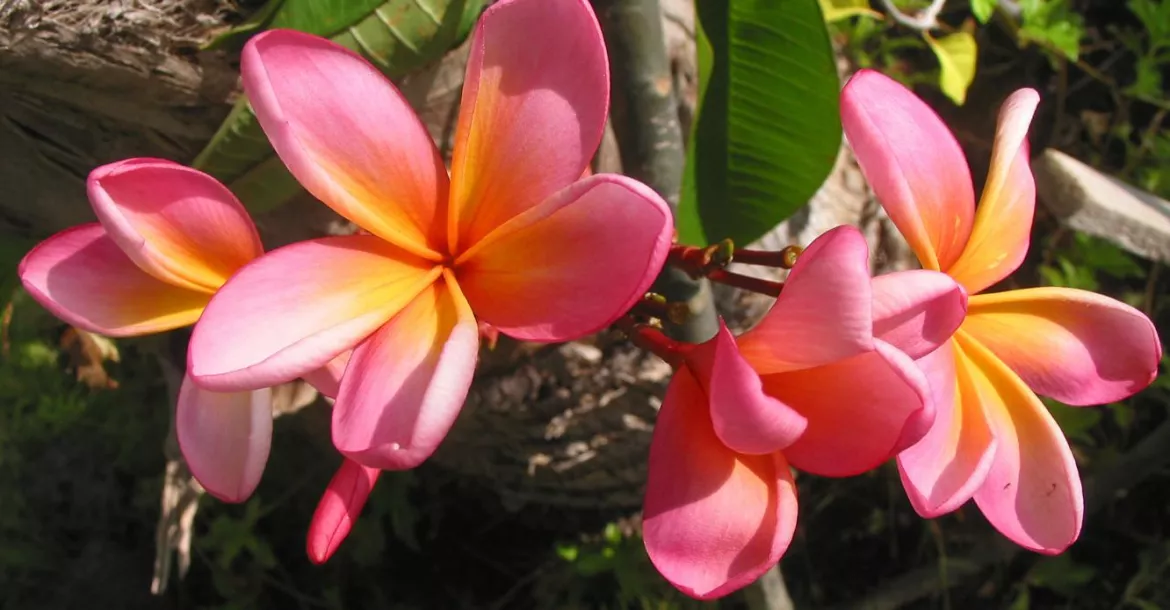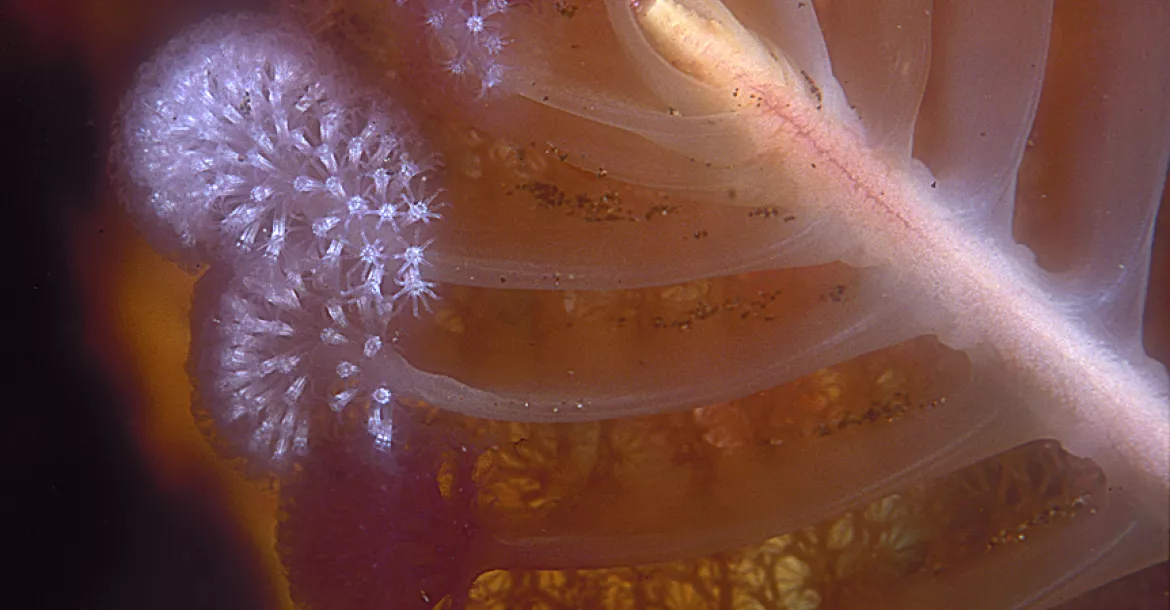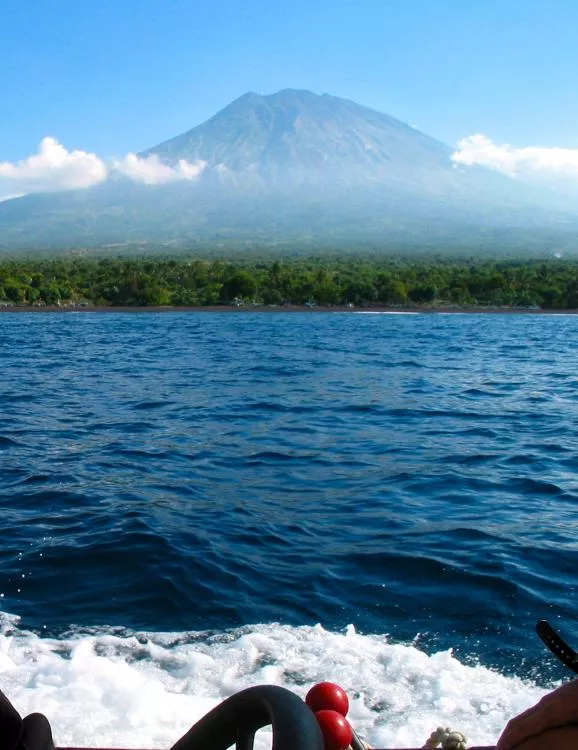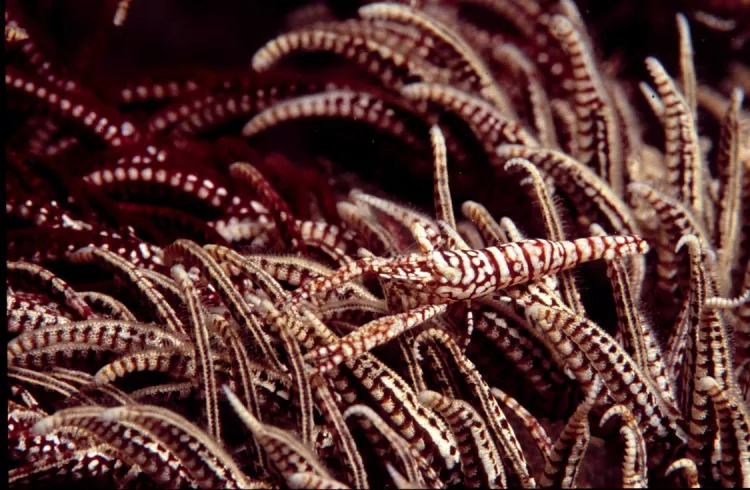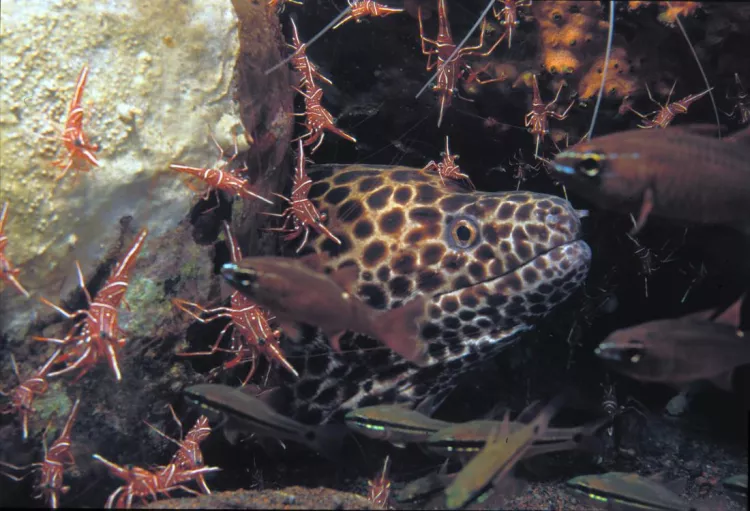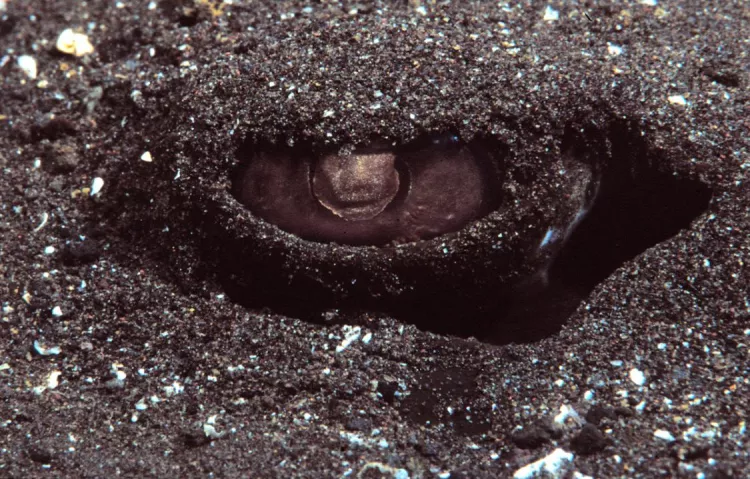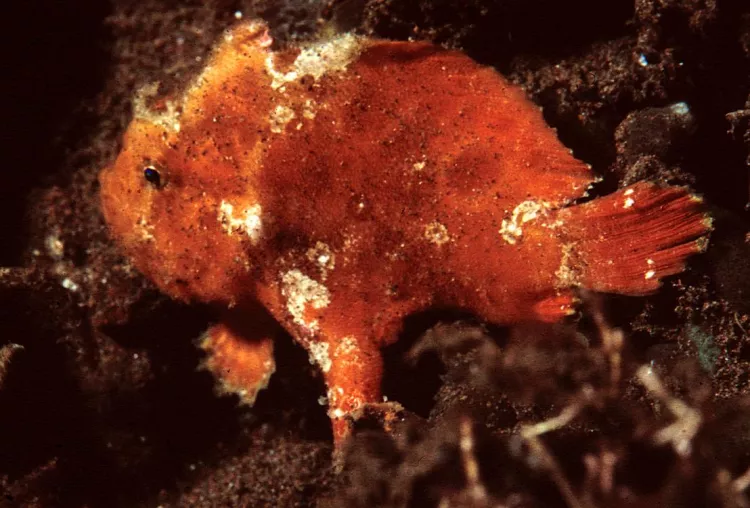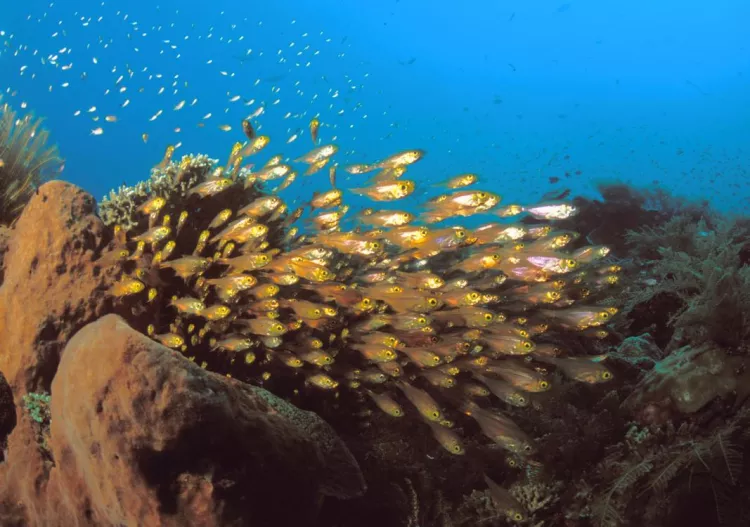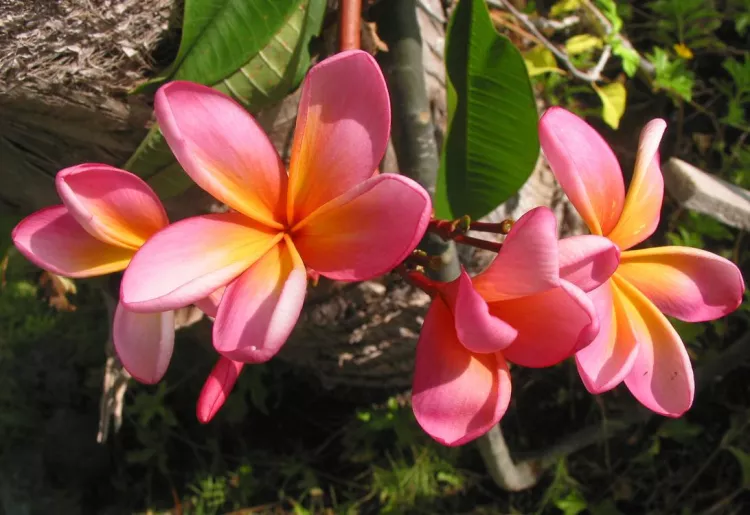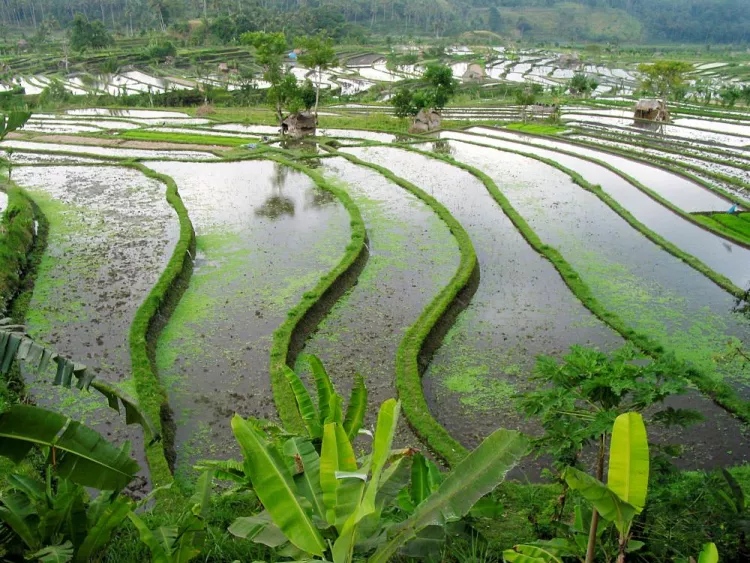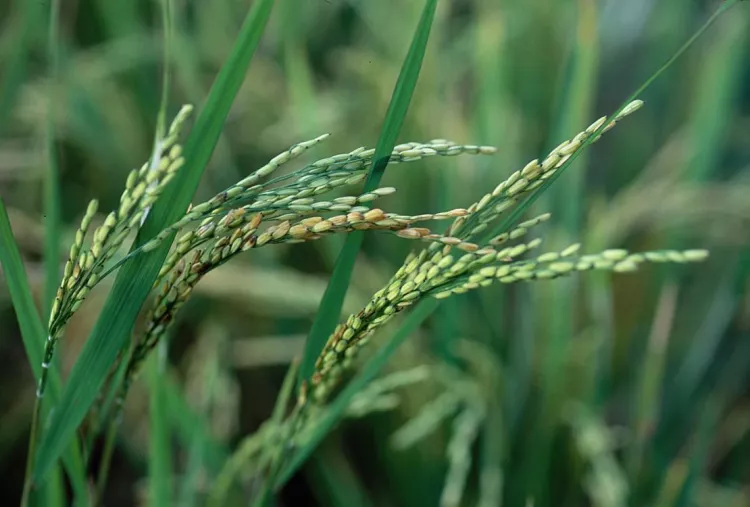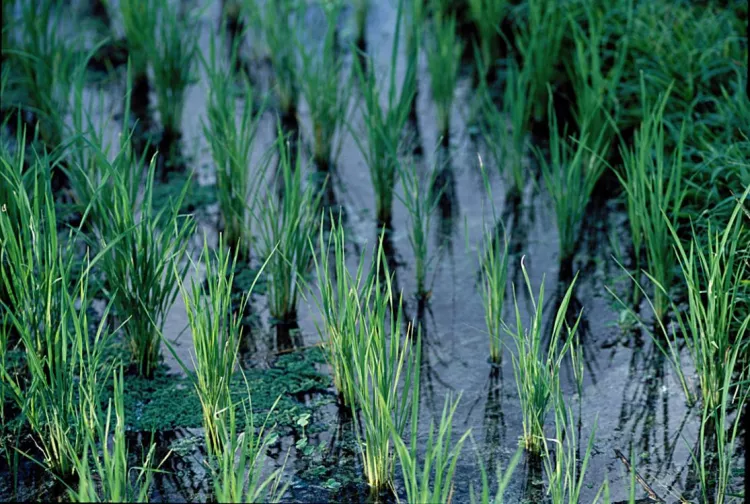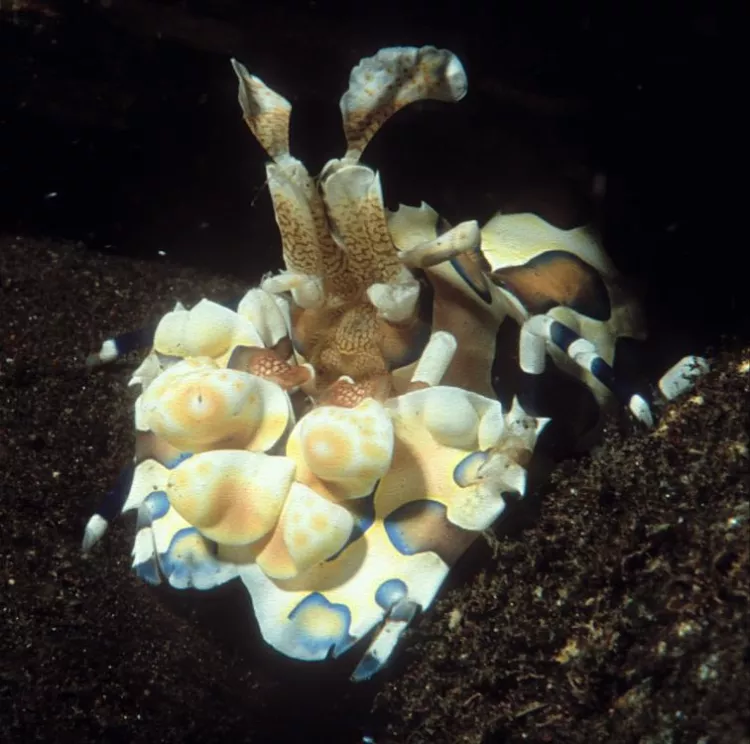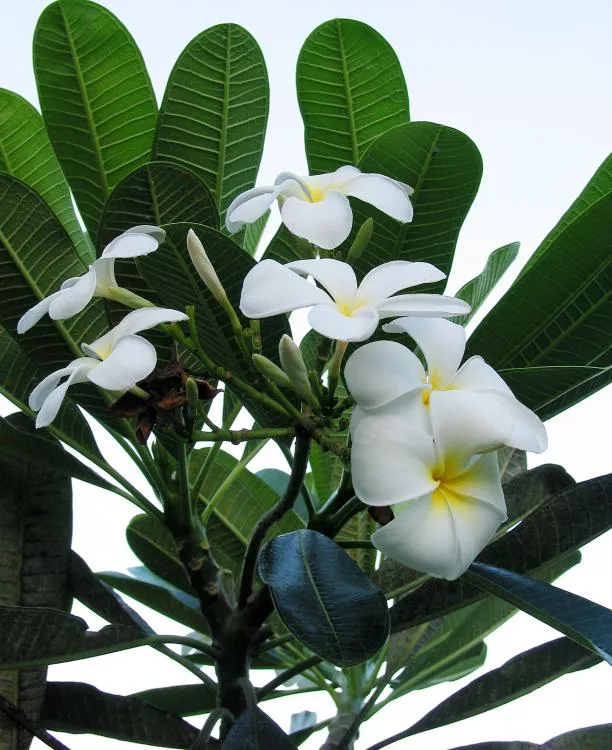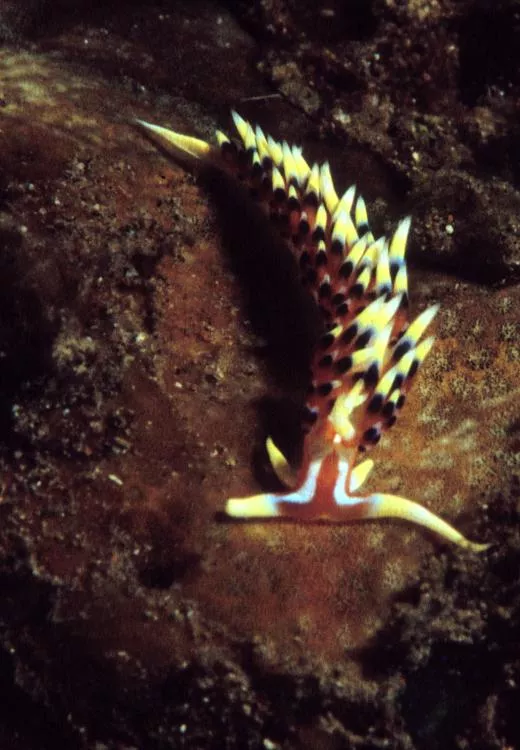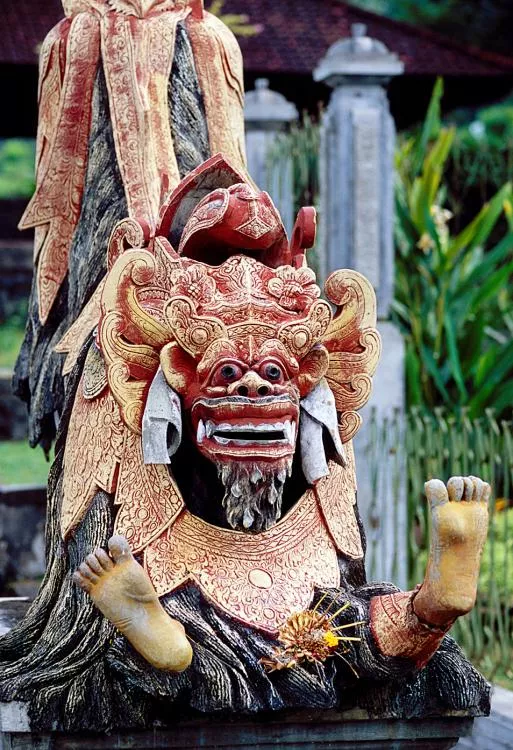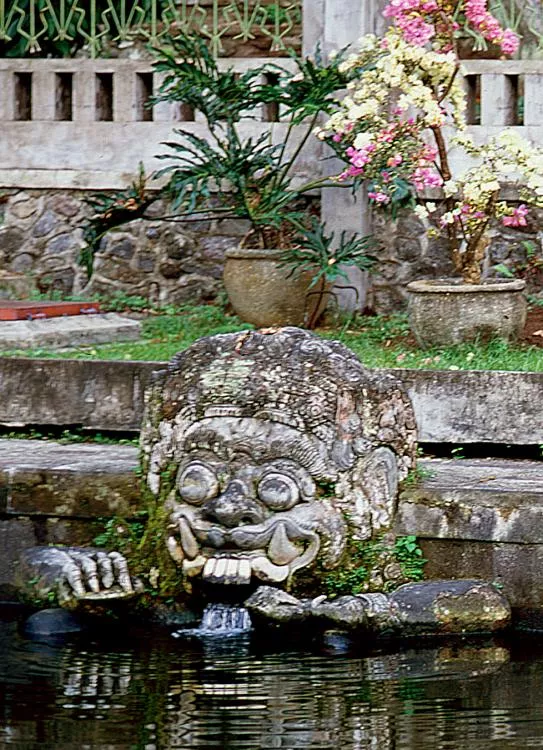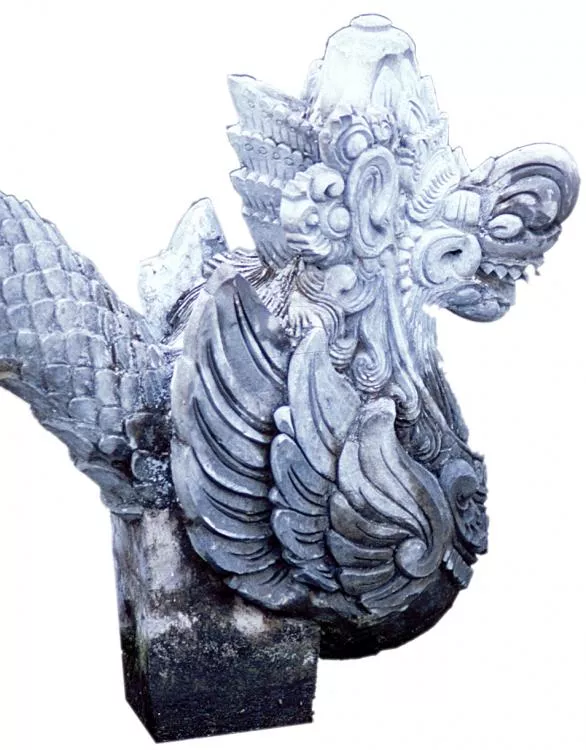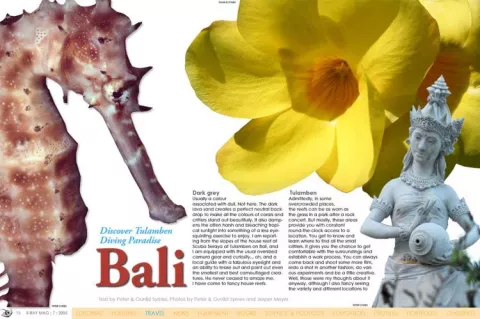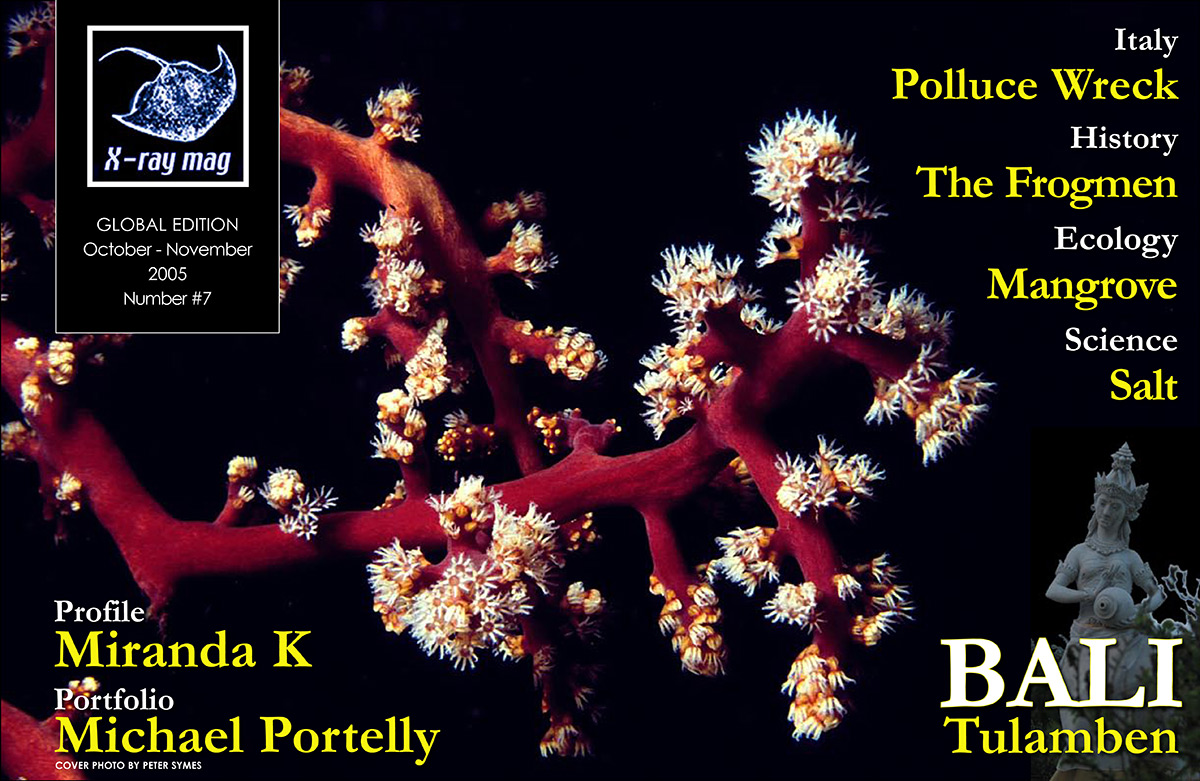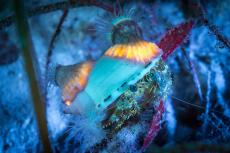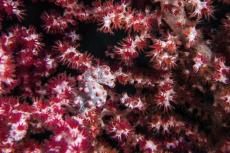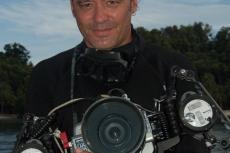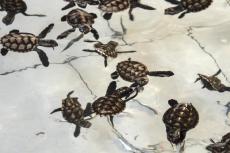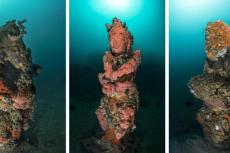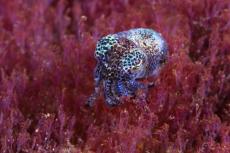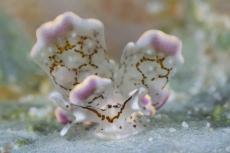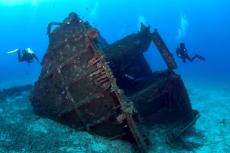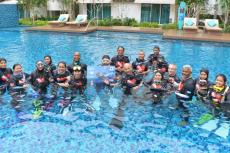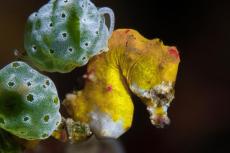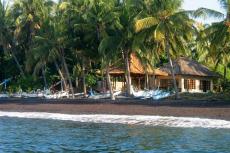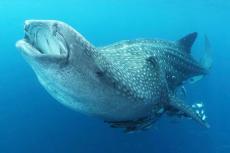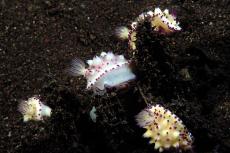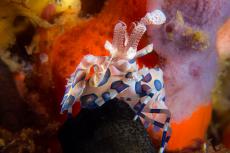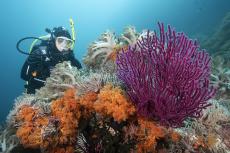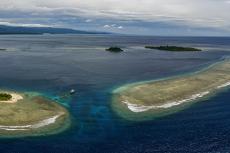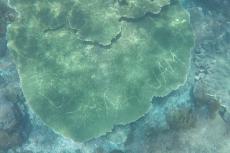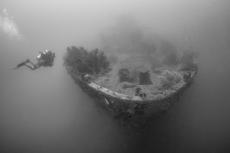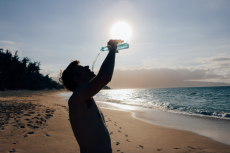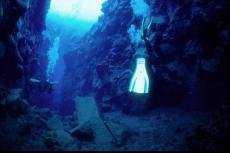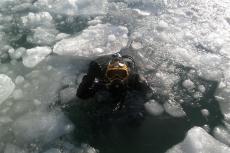Dark grey!
Usually a colour associated with dull. Not here. The dark lava sand creates a perfect neutral backdrop to make all the colours of corals and critters stand out beautifully. It also dampens the often harsh and bleaching tropical sunlight into something of a less eye-squinting exercise to enjoy.
Contributed by
Tulamben
Admittedly, in some overcrowded places, the reefs can be as worn as the grass in a park after a rock concert. But mostly, these areas provide you with constant round-the-clock access to a location. You get to know and learn where to find all the small critters. It gives you the chance to get comfortable with the surroundings and establish a work process.
You can always come back and shoot some more film, redo a shot in another fashion, do various experiments and be a little creative. Well, those were my thoughts about it anyway, although I also fancy seeing the variety and different locations to cover the whole spectrum
Tulamben proved to provide us with ample opportunities to do both. It is a site that holds quite a reputation among dive aficionados. Once we were on location ourselves, it was obvious why. It is said that it is the single best place in Bali to find rare and unusual animals.
Even on my first acclimatisation dive, I saw three different varieties, or species, of sea horses, half a dozen different nudibranchs and numerous juvenile paper frogfish, gobies and blennies.
The house reef, Seraya Secrets, is the perfect place for macro-photographers and naturalists because it never runs out of surprises, and it is so easily accessible right there in front of the resort. It starts with a shallow plateau where we could often find many different species of scorpionfish willingly posing for our lenses, or perhaps just trusting their camouflage to hide them from us.
Some 15-20m from the beach, the bottom starts to slope down more abruptly, so it is easy to get down to a depth of 25-30m quite quickly. The depth gauge is something that needs to be observed closely here. It seems easy to get carried away with all the marine life and end up going quite deep. The light is beautiful down here too.
In the first few days, we had a bit of an unusual swell that stirred up particles in the top layers, which created a matte filter of blue-greyish light that added a magical romantic touch to the sub-sea landscape.
The coastline looks towards the northeast, which means that light late in the afternoon will arrive from behind the slope. It brings out all the sculptural structures in the lava and the corals.
Once back topside, I couldn’t help contemplate how a dive location obtains its fame. This location, as such, is somewhat unassuming and doesn’t immediately stand out in comparison with so many other pretty locations on the planet or island.
No offense—the resorts here are very nice, comfortable and intimate and provide for a very enjoyable and relaxing get-away. Seemingly endless coastlines extend into the horizon. So why here, three hours away from the main tourist areas around Denpasar and Nusa Dua?
Liberty Wreck
One reason could be the Liberty wreck, one of the main dive attractions in the Tulamben area, and certainly one that holds fame beyond Bali.
This 120m wreck is said to be one of the easiest to dive, and sure enough, it lies just off the beach and a very short 35m swim from the coastline. It is lying on its starboard side parallel to the beach with the keel pointing towards the coast.
It lies port side and some of the twisted superstructure seems to be just below the surface. The wreck is indeed very nice because it is so accessible and covered with interesting growth. It is a good hiding place for a wide variety of sea life. As a wreck for wreck fanatics, it is probably less interesting as, for one, there are no artefacts to recover.
It is a WWII wreck indeed. It was a casualty of a Japanese torpedo. But the wreck actually first sat on the beach for more than 20 years, during which period everything worthwhile salvaging, including her propeller, was removed. The Liberty, not to be confused with a Liberty class vessel, was a cargo ship carrying rubber and railroad parts from Australia to the Allied forces in the Philippines, when she was struck by a torpedo in the nearby Lombok strait on January 11, 1942.
Two US destroyers took her on tow towards Singaraya hoping she could be repaired, but she was fatally wounded and took on too much water. She was then beached at Tulamben in an effort to keep her from sinking, but there was no time to salvage her cargo before the
Japanese invaded Bali. She then sat here for over two decades until 1963 when Bali’s highest mountain and volcano erupted violently and created earth quakes that rolled the ship off the beach and broke the hull in several pieces. It is no longer advisable to penetrate the wreck as it is starting to break up, and the steel is very fragile in places. But is still a haven to go look for creatures.
On my first dive I even caught a glimpse of the elusive pygmy sea horse. This was my first sighting of the species, and I was absolutely taken aback. I could not believe how small it was. Amazing... and truly pygmy, indeed. No wonder that they were only discovered in recent years.
We started the dive off the stern, which was decorated with majestic fan corals, and to the right, we saw the stern gun that was hastily retrofitted to the Liberty. This wreck is like the gardens of Babylon as regards to fan corals and other hanging or protruding corals, and within the branches, we see seahorses, shrimp, crabs, paper frogfish and a coupe of hawkfish.
Hiding in the wrecks, we see a school of grunts and trumpetfish dart around as travellies patrol the water above the wreck. The most obvious route to take first is the swim along the superstructure of the wreck as it lies at it deepest point.
One thing to be said about the wreck however is the early bird gets the worm. Get up early! It is said to be the most popular dive site in Bali, so it gets many visitors on a good day in the high season. Some of these visitors are driven all the way up from the major resort areas on the southern coast, so those who reside in the Tulamben area will have a couple of hours head start. I took a pre-breakfast dive with my guide and we had the wreck virtually to ourselves. It was wonderful, and back at the resort, I had a stack of yummy hot pancakes waiting.
Giant barrels
In the opposite direction, towards the eastern end of Tulamben bay, and just past that massive lava river has it’s now solidified outlet into the sea, there is another bluff under which we are going to have our next dive. This site is quite different and characterised by massive barrel sponges everywhere. It looks almost like a plantation, and a bit surreal. The diving is easy here.
There is little or no current and no need to move far anyway. The devil is in the detail here, so what you want to do is inspect the coral branches very closely and every other nook and cranny for exciting and weird-looking critters. Again, my trusty dive guide, Semut, proved to have a stunning eye for spotting even the smallest and most camouflaged creatures.
I simply did not have film enough, and while I was taking one shot, he was over at something else waving me toward him to see what he found. I just went from spot to spot. It was, however, all very relaxed.
Once I got back inside and uploaded my dive profiles onto my laptop, I saw that my average air consumption was very low—about half of what an average dive back home would have required. I had no problems extending my dives well beyond the hour or so, until hunger or craving for coffee drove me out of the water. With all the stuff going on in the shallows, you just can’t help hanging around as long as your air supply lasts.
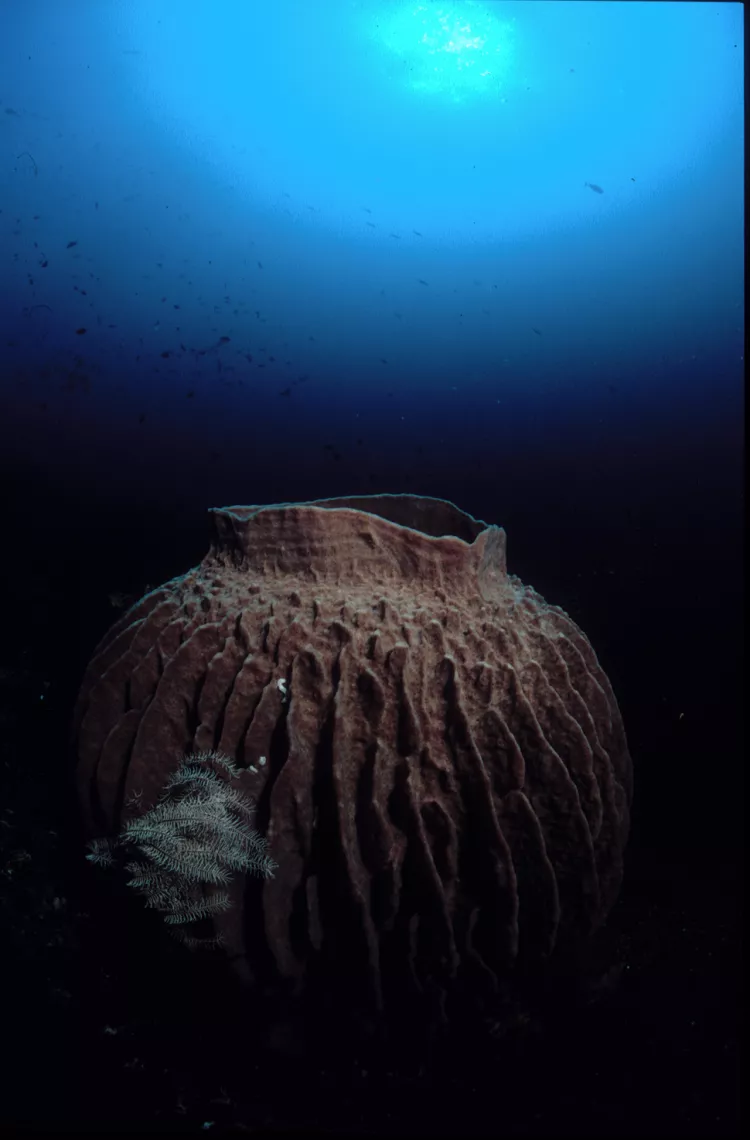
Tirtagangga Water Palace
A favourite day excursion from Tulamben is the Tirtagangga Water Palace. Tirtaganga, which in Balinese means “holy water of the Ganges”, was once home to royalty. The gardens and pools at the Tirtagangga Water Palace are now open to the public. Locals and tourists alike enjoy bathing in the pools fed by naturally filtered fresh water gushing from under an ancient Banyan tree perched on the mountain upon which the palace gardens reside. It is said that the waters here have healing qualities that lead to long life and health.
The modest palace was built by one of Bali’s last kings, Anak Agung Anglurah Ketut, in 1947. The Raja of Karangasem was inspired to build the palace and gardens after a tour of the Versaille Palace in France. The Raja chose the location for its view that overlooked his kingdom and named the gardens after the holy river Ganges in India, which is known for its healing powers.
We took a cab up the steep curving road that led us to the water palace. Our friendly cab driver was also a knowledgable tour guide and led us to strategic points along the way where he stopped to let us take photographs of the majestic countryside and mountainous terrain terraced in the traditional style with rice paddies climbing up the steep slopes.
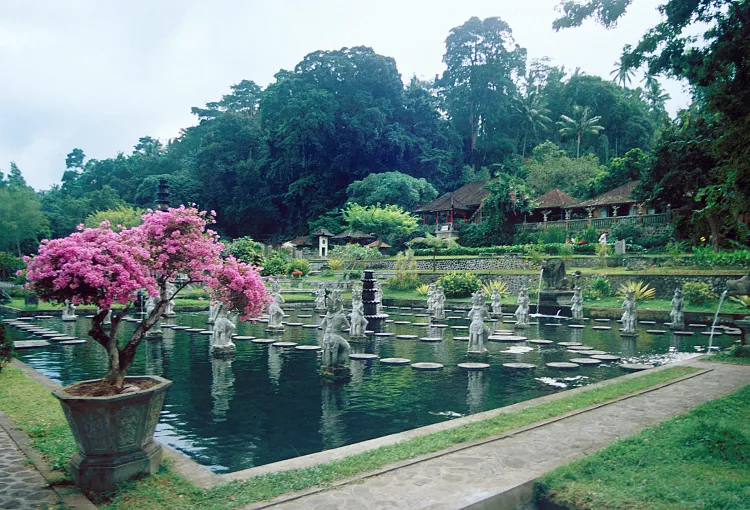
Once we arrived, we paid a nominal entry fee and were led by a kindly young priest who told us the story of the palace and the royal family that once lived there. Tragedy struck the palace gardens in 1963, when the volcano, Mt. Agung, erupted destroying much of the palace and statuary that graced its gardens and pools.
A continuing effort by the local community, priests and government leaders is helping to restore the gardens to its former glory. Local craftsmen and artists are rebuilding or renovating the damaged palace villas, which can be rented out by guests, as well as renovating the mythical statues that watch over the reflective pools.
Indeed, the statues, which characterize various gods and spirits, seem to float on the surface of the reflective pools. There are also steps throughout the pools upon which Balinese dancers dance during special events and festivals. Beautiful flowering trees and shrubs shower the gardens with brilliant colour and lovely flowers while elegant fountains carved of stone give life and sound to the reflective pools.
With a small fee that went to the maintenance of the park, the priest gave us an additional opportunity to see a slice of life behind the palace where fields of regional crops and wrippling rice paddy terraces are cultivated by the local farmers and their families who watch over the fields and scare away ravenous birds with loud shouts from small grass huts on stilts and a multitude of homemade noise makers that spin in the wind.
We walked through the fields of sweet potato, corn, rice and a spinach-like green leafy vegetable. Small canals irrigate the fields with rushing cold fresh mountain water. Children and families can be found bathing in them and cooling themselves from the ever-present heat and humidity.
The royal villas, including the King’s own domain, can be reserved for lodging. There is also a restaurant on the premises. For more information, visit their website:
www.aaabalivillas.com
The VW bus
We were setting out for another early pre-breakfast dive on a beautiful crisp morning. This time we were heading for the Tulamben drop-off and, according to Francesca, the dive manager, the fan coral was so big it was beyond belief. I must admit, I was a little bit sceptical—exaggeration is a national sport almost everywhere, but I would soon find out that she was right.
The Tulamben drop-off lies in the opposite end of Tulamben Bay so we had a 20 minute pleasant cruise before we arrived at our destination. Meanwhile, to our left, behind the beach and above the palm trees we could enjoy the sight of majestic mount Agung in the background.
When we congregated in the shallows, we came down onto a school of blue-spotted maskrays, some of them kept hiding in the sand only with their piercing eyes sticking out. They certainly don’t have a winning appearance, but they let me creep very close to take the picture of just their eyes.
We grouped and went on down the slope to explore the lava ridges, which from above, must look like a three-fingered hand jutting out from the coast with sandy areas between the fingers. On these ridges or narrow plateaus were fertile coral gardens with all sorts of corals swaying gently in the little current we encountered here. Small gorgonians were everywhere, black corals, sponges and table corals.
I traversed the “index-finger”, humming a tune, minding my own business and looking around when I saw it—The Big Gorgonian. It was still some distance away, but I couldn’t believe how it dwarfed the diver nearby. It seemed like it could hide a VW minibus. I moved closer and was struck by awe. It stood out like a Vincent van Gogh painting and resembled a blossoming cherry tree.
I had mounted my very wide-angle fish-eye setup for this dive. It can almost photograph my eyebrows and heels at the same time, but I actually had to back up and then some to get this giant radar antennae fitted within my viewfinder. It was very impressive and by far the biggest fan coral I’ve ever seen. At about 30m you can’t, however, hang around forever to admire this stunning creation, so I reluctantly started nudging myself up the slope again.
At my left, I had a very interesting drop-off falling vertically 10-20m down to a sandy bottom, a place I certainly would like to explore further the next time I visit this magical spot.
It looked like the current here ran perpendicular to the lava-finger and was forced up over it bringing the plankton and minuscule food particles right into the fanning tentacles of the corals. Further up, at mid-depths there was a bed of table corals where schools of cardinalfish were hiding inside the fronds.
Dining by the waves
The central meeting place for divers and guests at Scuba Seraya is the deck of the café in the centre of the resort. Here, guests can relax, socialize, plan their dives and look up fish and other creatures in guide books provided while gazing at the waves tumbling onto the beach and the small wooden fishing boats passing by far off on the horizon. There are some wonderful sunrises and sunsets to be enjoyed here.
While the new restaurant is being developed, the café serves a full menu of breakfast, lunch and dinner. On the menu, guests will find a variety of fresh and tasty dishes of local Balinese cuisine as well as some Western fare.
Favourites on the dinner menu include egg rolls with peanut sauce, a spicy Balinese grilled chicken dish called megoreng prepared in coconut cream and served with peanut sauce, rice and fresh vegetables, and nasi goreng, another spicy Balinese dish served with an egg sunny-side-up on top of a heaping mound of stir-fried rice and vegetables. On the side, you will find a special braised spinach-like leafy vegetable salad with spicy peanut sauce called gado gado—delicious and healthy.
For dessert there is a sweet dish of caramelized fried small finger bananas called godoh served with ice cream—excellent with Balinese coffee, which is also quite popular at breakfast time when divers can grab a quick continental breakfast before a morning dive or relax with a full Western style breakfast of bacon, eggs or omelette and toast or pancakes.
The lunch menu includes the Balinese rice dishes as well as pasta, fresh salads with tomato, olives and feta cheese, mushroom soup and sandwiches. For traditional Balinese recipes, please visit www.baliguide.com.
Blessing the Dive Centre
The local Balinese people live with their religion well integrated into their daily lives. Each day the women prepare offerings of flowers and fruits in small hand woven baskets that are placed along major pathways and intersections at the work place, outside and inside the home. It is believed that the gods and spirits of ancestors pass along these paths each day and so must be honoured with offerings and incense.
So, when a new building opens like Scuba Seraya’s new dive store and deck, a priest must be called in to do a proper blessing for the future safety and prosperity of the centre and the people who work there and visit.
As guests of the resort, we were invited to attend. All day long, preparations were made in the decoration of the new building and deck with flowers, candles and palm leaves as well as an elaborate display of offerings of fruit, flowers, rice cakes and grilled whole chickens set out as offerings during the ceremony.
Soon, all the resort staff appeared donning their fancy sarongs and headdresses that were usually saved for special occasions such as this blessing.
A priest was called, who came with incense and incantations. After a lengthy meditation and several holy songs, there was a sacrifice of a small chicken upon a coconut shell and the priest blessed all the corners of the dwelling with holy water. Then, he blessed all the people who attended the ceremony with holy water and prayer. With the priest’s work done, the participants turned to celebration—singing, dancing, eating and drinking.
Partying the Balinese way apparently also means consuming copious amounts of arak (or arrack)—a locally produced aromatic liquor. I can’t say whether this version, which was passed round the circle this evening, was moonshine, but it did come in a plastic flask from some soda drink. And, wow, was it not smooth! It had the bouquet of spent jet fuel and could possibly be used to strip the paint off my old desk.
Yet, as a mood elevator, it did it’s thing, and soon everyone was carried away in some entertaining song-dance where the dancer in the circle challenged the next with a song to take a drink and take over the dance.
Being a tourist didn’t mean that I was spared from this ritual, so I had to have a go at it too. I think I took the prize for the most humorous interpretation of traditional Balinese dancing that evening, judging from how they all cracked up and rolled over laughing. Well, after that, we all became true friends. As they say, when in Rome do as the Romans...
Night dive
Having this fabulous house reef just 20 metres from the deck where we had our dinner and Balinese coffee encouraged us to have a night dive before a late supper. In the tropics, night drops like a ton of bricks—it becomes pitch black moments after sundown, and the sky turns a deep black velvet with an unbelievable amount of stars draped across its face.
But even without sunlight shining on the dark sand of the Tulamben sea floor, the human eye is still capable of picking out the surroundings. With a healthy local stock of scorpionfishes, I wasn’t so inclined to feel my way forward, and anyway we were on the lookout for the blue-ringed octopus that was spotted here a little earlier in the week.
I went out with the resort’s English instructor, James, into the black night. We saw so many commensal shrimps, juvenile fish, various cupcorals, crinoids, brittlestars, nudbranchs and almost omnipresent seahorses, that we were almost disgusted with ourselves. We were so blessed with such a magnificient dive. It was like a double-length movie that we didn’t want to end. There was such a plethora of species out that night. Everywhere, there was something to see, and we just kept moving.
Alas, no blue-ringed octopus. It wasn’t going to happen this night. After 1½ hours of pure joy, we two seasoned instructors finally emerged out of the water with goofy, happy expressions on our faces and spent bodies starving for supper. A heaping mound of steaming Nasi Goreng was already waiting for us on the table.
Diving Batu Kelebit
The Kelebit Rocks are said the be a good place to observe large pelagics. At this site, we find a series of three steep coral-covered ridges fanning out from the coast with channels of white, not black, sand in between. It is also a place where it is possible to go very deep if you follow the ridges all the way down. They end in a sandy slope at about 70m, a depth that should certainly not be approached on ordinary single tank scuba equipment.
A number of big sharks have been observed at depth at this site, but not as frequently as they once were. Most sightings have been made down at the 50-60m range.
Sightings include great hammerheads, thresher sharks, mantas and molas (sunfish) and the rare whaleshark. Also, schools of barracudas, jacks and tuna are best spotted here. The reason for this seems to be that because of the local morphology, Batu Kelebit receives deep offshore water that also brings in nutrients and plankton.
Because of this, the temperatures here also seem to be on the cooler side, especially at depth, but then it also comes with quite a good visibility at depth. There is a bit more turbidity in mid-water where the plankton seems to congregate.
Diving Batu Kelebit
We decide to head for the depths straight away and not hang around at shallower depths for the first part of the dive. Down and down I go until I feel the tinge of narcosis and an unruly stomach round 45m where I stop my descent. I can see all the way down to the sandy bottom here.
After a week of daily +30m dives, I am on the verge of pushing the edge. My buddy descends to about 55m. I swim across the ridges while ascending gradually, keeping just ahead of a decompression obligation.
On the other side of the big ridge I see them—Sharks—the first ones I have spotted after a week of intense macro photography. These were the usual white tips resting on the bottom. They lifted off the bottom and swam away once they caught a glimpse of us under-designed bubble-expelling noisy creatures with weird metallic protrusions.
The ridges themselves were covered with a very rich and diverse growth of hard corals, black corals, sponges, gorgonians and every other imaginable encrusting animal.
Northwest
Close to Bali’s northwest corner, we find Majangan Island, another of Bali’s famous dive sites and probably the first recognised dive location. It is part of the West Bali National Park and is protected by a great bay, which gives rise to exceptional visibility and good diving even during the rainy season. The light currents that gently sweep the steep drop-offs are just right to provide the optimum living conditions for a lush abundance of gorgonians.
Gorgonians are dependent on current to bring them the plankton upon which they feed, but too strong currents will break their delicate structure.
The impressive walls with overhangs of soft corals and gorgonians are a hallmark of Majangan Island. It is not the best site to see large pelagics and some of the reefs in the shallows have suffered heavily from coral bleaching due to the severe effects of El Nino in the late 1990’s.
At depth there is even an interesting little wreck called by many as the Anchor wreck after the anchor was found in the shallows far above the wreck itself. The wreck, which is rather broken down and mostly consists of scattered timbers and remains, does however lie in the 40-50m range just beyond the 40m recommended depth limit for recreational divers.
Under all circumstances, it is in a depth range that will give you very short bottom time or send you directly into a decompression obligation. For those trained in decompression procedures, the shallower parts of the reefs provide plenty of entertainment while decompressing.
However, a word of caution is warranted—the depths around Majangan often run down between 40-60m, and one is easily tempted to push the limits here. It also said to be the site where more divers get decompression sickness than anywhere else on the Island.
Secret Bay
Also in the northwest Bali, but facing the Java and the Bali Strait, we find Gilimanuk Bay also known as Secret Bay, which is, however, something of a misnomer since this is where the ferry from Java lands and is probably the best mapped of all the waters around Bali. The bay is only a couple of kilometres across, quite shallow and lined with mangroves and very little of the colourful corals that attract divers elsewhere.
So what’s the attraction here? Well, the bay is the only bay along the Bali Strait that is subject to strong currents, and because of these huge exchanges of water, Gilimanuk has become a very interesting place—it acts as a naturally protected fish nursery and natural aquarium for fish larvae.
Here the macro-photographer can find both rare subjects such as dragonets, shrimpfish, various odd gobies, juvenile batfish as well as excellent circumstances for photographing critters in general. Here, a lot of species can be found at shallower depths than anywhere else on the island, and the fish and invertebrates seem to be in a very good feeding condition thanks to the daily influx of nutrients into the bay.
Due to the tidal currents constantly flushing the bay, visibility can vary a lot—so can the temperature where bay and upwelling ocean waters mix to produce some surprising cold fronts for the unsuspecting diver.
Gili Selang
In the northeastern corner, which is in fact Bali’s easternmost point, we find Gili Selang located somewhat like an outpost in the current-swept Lombok strait. This is also where the black sands of the northern beaches meets the east coast.
All the schooling fish in the currents create an interesting mix of biota and bottom types along the slopes of black sand, areas of big polished stones and steep valleys. Everyone seems to utter the word current in the same sentence as Gili Selang, and it is a site that the dive guides and experienced repeat visitors talk about a lot during dinner conversations.
The exposed position does give rise to some rather wild drift dives. Great fun, if you are comfortable in the water, have some experience and can master your buoyancy, so you can enjoy the various schooling fish who seem to like to congregate here, especially jacks, barracudas, trevallies and the occasional humphead parrotfish. Whitetip sharks are also common here.
The coral cover seems to be predominantly leather corals with some gorgonians where the current is less severe. The north end of the area mostly resembles the Tulamben area with its black sands and gentle slopes full of life. Whereas, the southern part around the island is dominated by the current, which continues south and even down the slope. It is something that might drag the unsuspecting diver a fair bit further downwards than expected. Watch the depth and the current here. Keep to the right and go behind the island to find some shallower areas in which to end your dive.
East Coast - Amuk bay
This area holds some of the most exciting but also most challenging dive sites on the island, again due to the sometimes ferocious currents. Sharks are seen on virtually every dive. Molas are quite frequent and fish life is, in general, very rich. But the swells and swirling currents, especially around the islands of Mimpang, Gili Tepegong and Gili Bahia, can be unpredictable and should be dealt with accordingly. The upwelling of cold rich water is, however, what brings in a rewarding abundance of pelagic species.
These sites are challenging but can be very rewarding. For instance, at the aptly named Canyon on Gili Tepegong can be draped with schools of sweetlips and fusiliers against a dramatic backdrop of black bolders and steep walls. It is considered by many to be the best dive site here. Under some conditions, the Canyon appears to be filled with fish. However, the currents can be a real issue here. Under certain conditions, a strong and downward spiralling current can be produced.
Conditions need to be assessed closely before entering the water. Because of the currents and the polishing surge, the coral cover is also rather modest, but it is not what this site is about at any rate. It is about the dramatic images and structures made by naked rocks and swarms of fish.
Tangjung Sari
Skimming the literature on Balinese diving, the Tangjung Sari peninsula doesn’t seem to get very rosy reviews, and as far as first impressions, it doesn’t have much going for it either. It has a bottom of light sand with some scattered rocks and quite sparse cover of corals and hydroids.
But first impressions can be deceiving, as the site has been found to be an excellent place to spot a wide range of unusual fish—especially some of the rarer sharks including wobbegongs, nursesharks and strange-looking catsharks, not to mention the omnipresent whitetips and the occasional napoleon wrasse. It is also a good site to spot squid and octopus as well as a good variety of stonefish and pipefish.
David Pickell and Wally Siagian write in their recommendable guide, Diving Bali, that they have spotted “many oddities” here and mention stargazers, walking scorpionfish and many species of rays of which some are not seen elsewhere on Bali. They also rate this site as one on the most surprising and underappreaciated on the island.
The site has for many years during the day time, been a quite popular destination for snorkelling trips out of the nearby Candi Dasa. But at night, the divers can have it all to themselves, and it is an excellent site for night dives. It is shallow, protected and conveniently positioned just around the corner from Padang Bai.
Current Carrousels - Nusa Penida
Lying across the Badung strait, some 20kms from Bali’s east coast, we find Nusa Penida, Nusa Ceningan and Nusa Lembongan. The islands can be reached by dive boat in about an hour from Sanur or Padang Bai. Most dives sites here lie to the north around Lembongan and Nusa Penida and in the channel between Ceningan and Nusa Penida.
All dive sites are steep slopes or walls which go down very deep. The water here is fairly cold but often remarkably clear with gorgeous corals and prolific fish life, some turtles, sharks and the seasonal oceanic sunfish—or molas for short, after their latin name mola mola.
Currents can be really strong around these islands because they lie right in the path of the Indonesian Throughflow (see fact file). The Lombok Strait separates the Indonesian islands Bali and Lombok and is the second most important strait through which water is exchanged between the Pacific Ocean and the Indian Ocean. The water is also subject to considerable thermoclines jumping from about 24º to 18ºC making a good wetsuit more of a necessity rather than just a recommendation. This cold water comes from a 1300m deep basin north of
Nusa Penida, which sits as a large barrier to the currents coming from the north and produces strong upwellings of cold water. Consequently, some of these dive sites are not recommended for beginners. It is also a good idea to have your own safety sausage and a signalling device for attracting attention at the surface.
Nusa Penida
The main points of interest diving Nusa Penida, the largest of the three islands in the group, are the large pelagics such as giant trevally, sharks, mantas, eagle rays and turtles. The majority of diving at Nusa Penida is drift-diving, and the currents can be unpredictable reaching up to five knots and coming from every possible direction including up and down.
Places on the north coast, on the other hand, offer less extreme currents and a variety of fish that seem to prefer calmer waters. Spectacular barrel sponges and gorgonians can be seen in the deeper waters, sea snakes are very often seen here and occasionally manta rays and schools of chevron barracudas pass by.
Also, Gamat Bay is a small sheltered and shallow bay located between Toyapakeh and Crystal Bay and is another of the few places on Nusa Penida where you can do more than drift dive. In the shallow areas, there is a lot of interesting macro life. Malibu Point, on the east coast of Nusa Penida, is said to be the best place to see sharks and schools of large pelagics such as jacks, dog tooth tuna, rainbow runners, sharks and mantas.
However, this site is also known to be tricky to dive, and if you are not careful, the current can sweep you off the point and into the strait. Manta Point is a safe bet to see manta rays, but the site can be hard to reach in the swell, which is usually quite strong, giving you a rough ride on the way there.
Lembongan Island
Lembongan island lies northwest of Ceningan island but is larger with shallow areas where there are seaweed farms and mangrove forests. It is a fairly small island with pristine unspoilt beaches. With its adjacent deep water trenches, the main attraction at Lembongan Island is the common encounters with the curious molas feeding off large plankton and jellyfish. They can also often be seen at cleaning stations with attendant cleaner wrasse.
The sunfish season on Lembongan starts in July, but the most reliable time to see them is August through September. In some years there have been sightings lasting until November, and often the molas are sighted shortly during March. The best places to spot them are Ceningan channel and Blue Corner in Lembongan.
The molas come very close to the reef to certain cleaning stations where they get cleaned by schooling bannerfishes or occasional angelfishes or butterflyfishes. Some believe they come here to mate, but this thought remains speculation.
Blue Corner is a steep slope with overhangs, outcroppings and a wide canyon. This dive site, while quite deep at 30-40m, is a good place to see marble rays and eagle rays. Depending on tide there is either no current or a very strong current. In strong current, you can hide behind some of the outcroppings or overhangs often to find that the rays are also hiding from the current here.
Mangrove Point is named after the mangrove forest lying between Lembongan and Ceningan. This is a nice drift dive on a slope covered with huge sponges where you may spot sharks, turtles and tunas. The Ceningan Channel is characterised by a strong current and by being quite cold, but you might see white tip reef sharks and eagle rays here. Crystal Bay is a part of the channel, which consists of a large sandy area of staghorn corals and mushroom coral blocks that hide big schools of cavalier fish.
Here, we also find the “Bat Cave.” This is a cave accessed through a sandy underwater channel where it is possible to surface inside. The cave has a small opening to the sky where all the bats that hang from the walls enter.
Ceningan Point lies at the northern tip of Ceningan island. Here, the currents are strong and unpredictable and only few operators go here. It is worth a visit, but is only for experienced divers. A steep wall is beautifully covered with orange soft corals, sponges, a special tube coral and dense schools of reef fishes.
Conclusion
How does Bali stick out from the crowd? In Tulamben, the extremely prolific macro-life of the shallows and shipwreck in combination with the molas and the current dives in the cooler waters around the strait does set the destination apart, but so does the special top side ambience of the terraced mountain terrain and Balinese culture.
Tulamben is a great place for the discerning photographer and advanced diver. It is also a very romantic getaway for couples. It is not an obvious family destination, at least not for those with small kids who may be better off heading for the fine beaches found in the southern part of the island. Overall, Bali delivers in every aspect. After devastating blows from terrorism three years ago, Bali is once again a blossoming destination. ■
Published in
-
X-Ray Mag #7
- Läs mer om X-Ray Mag #7
- Log in to post comments

